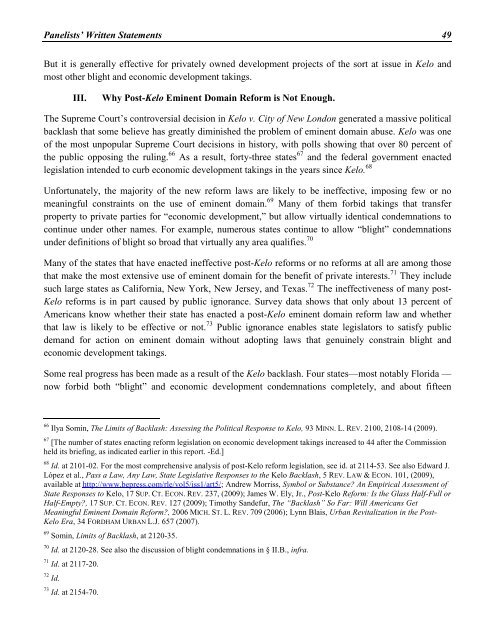You also want an ePaper? Increase the reach of your titles
YUMPU automatically turns print PDFs into web optimized ePapers that Google loves.
Panelists’ Written Statements 49But it is generally effective for privately owned development projects of the sort at issue in Kelo andmost other blight and economic development takings.III.Why Post-Kelo <strong>Eminent</strong> <strong>Domain</strong> Reform is Not Enough.The Supreme Court’s controversial decision in Kelo v. City of New London generated a massive politicalbacklash that some believe has greatly diminished the problem of eminent domain abuse. Kelo was oneof the most unpopular Supreme Court decisions in history, with polls showing that over 80 percent ofthe public opposing the ruling. 66 As a result, forty-three states 67 and the federal government enactedlegislation intended to curb economic development takings in the years since Kelo. 68Unfortunately, the majority of the new reform laws are likely to be ineffective, imposing few or nomeaningful constraints on the use of eminent domain. 69 Many of them forbid takings that transferproperty to private parties for “economic development,” but allow virtually identical condemnations tocontinue under other names. For example, numerous states continue to allow “blight” condemnationsunder definitions of blight so broad that virtually any area qualifies. 70Many of the states that have enacted ineffective post-Kelo reforms or no reforms at all are among thosethat make the most extensive use of eminent domain for the benefit of private interests. 71 They includesuch large states as California, New York, New Jersey, and Texas. 72 The ineffectiveness of many post-Kelo reforms is in part caused by public ignorance. Survey data shows that only about 13 percent ofAmericans know whether their state has enacted a post-Kelo eminent domain reform law and whetherthat law is likely to be effective or not. 73 Public ignorance enables state legislators to satisfy publicdemand for action on eminent domain without adopting laws that genuinely constrain blight andeconomic development takings.Some real progress has been made as a result of the Kelo backlash. Four states—most notably Florida —now forbid both “blight” and economic development condemnations completely, and about fifteen66 Ilya Somin, The Limits of Backlash: Assessing the Political Response to Kelo, 93 MINN. L. REV. 2100, 2108-14 (2009).67 [The number of states enacting reform legislation on economic development takings increased to 44 after the Commissionheld its briefing, as indicated earlier in this report. -Ed.]68 Id. at 2101-02. For the most comprehensive analysis of post-Kelo reform legislation, see id. at 2114-53. See also Edward J.López et al., Pass a Law, Any Law, State Legislative Responses to the Kelo Backlash, 5 REV. LAW & ECON. 101, (2009),available at http://www.bepress.com/rle/vol5/iss1/art5/; Andrew Morriss, Symbol or Substance? An Empirical Assessment ofState Responses to Kelo, 17 SUP. CT. ECON. REV. 237, (2009); James W. Ely, Jr., Post-Kelo Reform: Is the Glass Half-Full orHalf-Empty?, 17 SUP. CT. ECON. REV. 127 (2009); Timothy Sandefur, The “Backlash” So Far: Will Americans GetMeaningful <strong>Eminent</strong> <strong>Domain</strong> Reform?, 2006 MICH. ST. L. REV. 709 (2006); Lynn Blais, Urban Revitalization in the Post-Kelo Era, 34 FORDHAM URBAN L.J. 657 (2007).69 Somin, Limits of Backlash, at 2120-35.70 Id. at 2120-28. See also the discussion of blight condemnations in § II.B., infra.71 Id. at 2117-20.72 Id.73 Id. at 2154-70.


